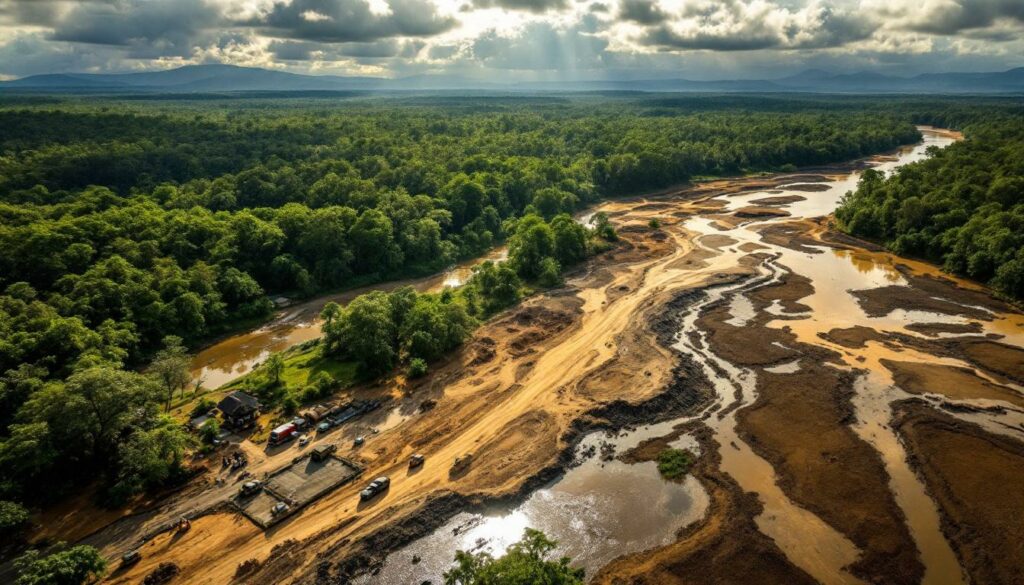Peru's Battle Against Illegal Mining: A National Crisis
Peru's fight against illegal mining has reached a critical turning point as the government implements sweeping changes to tackle an industry that has spiraled out of control. With thousands of miners operating outside legal frameworks, the environmental damage and social conflict have pushed authorities to take decisive action in what many see as a last-ditch effort to regain control of the country's valuable mineral resources.
The Scale of Peru's Informal Mining Problem
Peru's mining sector faces a monumental challenge as recent government actions highlight the true extent of illegal operations throughout the country. In July 2025, the government removed 50,565 miners from the REINFO temporary permit program, leaving only 31,560 miners in the formalization process. This dramatic reduction—representing over 60% of all registered miners—reveals the program's failure to meaningfully transform informal operations into legitimate businesses.
Energy and Mines Minister Jorge Montero confirmed that at least 45,000 of the excluded miners had shown no registered activity over the past four years, effectively using the program as a shield for operations without making progress toward formalization.
"The sheer number of inactive registrants demonstrates how the REINFO program was being exploited rather than used as intended," mining analyst Maria Sanchez explains. "These weren't miners working toward legality—they were simply using permits as cover for unregulated operations."
The informal mining sector has grown to become a significant economic force, with illegal gold production alone estimated to account for approximately 6% of Peru's GDP according to the Global Initiative Against Transnational Organized Crime. This economic weight makes addressing the issue politically challenging, as thousands of families depend on mining income despite its illicit nature.
Key Regions Affected by Illegal Mining Activities
The geography of Peru's illegal mining crisis spans multiple regions, each with distinct challenges:
- Madre de Dios: The epicenter of illegal gold mining in the Amazon rainforest, where mining has destroyed over 100,000 hectares of pristine forest
- La Libertad: Northern Peru's mining zone that recently experienced extreme violence, including the kidnapping and murder of 13 gold mine workers
- Arequipa and Puno: Southern regions where informal mining has led to violent protests and roadblocks
- Cajamarca: An area where tensions between formal mining companies and illegal operators frequently erupt into conflict
Peru's copper corridor has become particularly volatile, with recent blockades and protests demanding "unconditional formalization" for all miners, regardless of compliance with environmental or safety regulations. These demonstrations have occasionally shut down key transportation routes, affecting the country's crucial mining exports.
"What we're seeing is a country divided into zones where the state has effectively lost control," notes security consultant Felipe Rodriguez. "In some mining areas, illegal operators have more authority than government officials."
How Has Peru's Formalization Program Evolved?
The REINFO Program: Origins and Purpose
The REINFO program (Registro Integral de Formalización Minera) began in 2012 as a temporary measure to bring Peru's vast informal mining sector into compliance with legal, environmental, and labour standards. Initially conceived as a two-year transition period, the program has been extended multiple times, with the current extension set to expire at the end of 2025.
"REINFO was designed as a bridge, not a permanent solution," explains former Mining Ministry official Carlos Vega. "The idea was to create a pathway for miners to gradually meet regulatory requirements while continuing to operate and earn income."
The program established a registry where informal miners could declare their operations and receive temporary permits while working toward full compliance with mining regulations. Requirements included:
- Environmental impact assessments
- Land use authorizations
- Water usage permits
- Safety protocols implementation
- Tax registration and compliance
Despite these requirements, the program has seen limited success in achieving its core objective of transforming informal operations into fully compliant businesses. Of the more than 80,000 miners who have registered since the program's inception, only a small fraction have completed the formalization process.
Criticisms and Shortcomings of REINFO
The REINFO program has faced widespread criticism for enabling illegal mining rather than reducing it. Government officials acknowledge that many workers have exploited temporary permits to mine in prohibited areas, including protected natural reserves and indigenous territories.
"REINFO became a license to operate illegally rather than a path to formalization," states environmental attorney Lucia Mendoza. "The temporary permits were treated as permanent authorizations with no consequences for non-compliance."
Key criticisms include:
- Exploitation of loopholes: Miners operating on third-party property without proper authorization
- Environmental non-compliance: Continued use of mercury and other prohibited practices
- Lack of progress verification: Minimal oversight to ensure steps toward formalization
- Indefinite extensions: Political pressure resulting in continual postponement of compliance deadlines
- Weak enforcement: Insufficient resources dedicated to monitoring registered miners
Each time the government has attempted to end the program or enforce stricter compliance, it has met with fierce protests and resistance from mining communities. This has created a cycle of concessions that undermined the program's original intent.
Why is Illegal Mining So Difficult to Combat in Peru?
Economic and Social Factors Driving Informal Mining
The persistent challenge of illegal mining in Peru stems from powerful economic incentives and limited alternatives for workers in mining regions. Rising gold prices hovering around $3,398 per ounce (as of July 2025) and copper at $5.06 per pound create irresistible financial motivation for impoverished communities.
According to World Bank data, approximately 68% of Peru's rural mining towns lack diversified economies, leaving residents with few employment options beyond extraction activities. This economic dependency creates a social structure where challenging illegal mining threatens entire communities' livelihoods.
"For many families, the choice isn't between legal and illegal mining—it's between mining and hunger," explains sociologist Eduardo Ramirez, who studies mining communities. "When alternative employment doesn't exist, enforcement alone cannot solve the problem."
The typical illegal miner can earn 3-5 times the minimum wage, creating a strong economic incentive that outweighs potential legal consequences. This income disparity makes traditional enforcement approaches largely ineffective without addressing underlying economic conditions.
Governance Challenges in Mining Regions
Peru's geography presents enormous challenges for governance and enforcement. Many mining operations exist in remote Andean highlands or deep within Amazonian forests, areas where government presence has historically been limited.
The practical difficulties include:
- Accessibility issues: Remote locations require significant resources to monitor and patrol
- Limited infrastructure: Lack of roads, communications, and government offices in mining regions
- Corruption concerns: Local officials sometimes compromised by mining interests
- Overlapping jurisdictions: Confusion between national, regional, and local authority
- Resource constraints: Insufficient personnel to monitor vast mining territories
"You cannot govern what you cannot reach," notes former Interior Minister Carlos Basombrío. "In many mining regions, the state is simply absent, creating governance voids filled by whoever has the most economic or coercive power."
This governance challenge is compounded by the difficulty in distinguishing between legitimate small-scale miners and illegal operators, as operations often exist on a spectrum of compliance rather than clear legal categories.
What Violence Has Resulted from Illegal Mining Activities?
Recent Incidents and Fatalities
The human cost of Peru's illegal mining crisis has been severe, with violence escalating dramatically in recent years. According to the Peruvian Ombudsman's Office, mining-related conflicts resulted in 127 deaths in 2024 alone, marking one of the deadliest periods in the country's mining history.
President Dina Boluarte was forced to temporarily suspend all mining activities in northern Peru following a shocking incident where 13 gold mine workers were kidnapped and executed. This extreme measure highlighted the government's struggle to maintain basic security in mining regions.
"These weren't random acts of violence," explains security analyst Javier Torres. "They represent systematic territorial disputes between rival mining groups fighting for control of profitable areas."
The violence takes several forms:
- Territorial conflicts: Rival mining groups clashing over valuable deposits
- Resistance to enforcement: Attacks on police and military personnel during operations
- Extortion and organized crime: Criminal groups demanding "protection payments"
- Community conflicts: Disputes between pro-mining and environmental protection factions
- Labour disputes: Conflicts between workers and informal mine operators
These incidents have created a climate of fear in many mining regions, further complicating governance and formalization efforts.
Security Measures and Enforcement Efforts
In response to escalating violence, Peru has implemented increasingly militarized security measures in high-conflict mining areas. These include:
- Deployment of specialized police units equipped with anti-mining operation training
- Military support for large-scale enforcement operations
- Helicopter surveillance of remote mining sites
- Coordination centers between different security agencies
- Emergency powers declarations in extreme conflict zones
"We're essentially conducting counter-insurgency operations rather than routine law enforcement," explains a high-ranking police official who requested anonymity. "The level of organization and armament among some illegal mining groups requires military-grade response."
The government has allocated $46 million to combat illegal mining in 2025, representing a significant increase from previous years. However, experts question whether this investment is sufficient given the scale and profitability of illegal operations.
How Is Peru Strengthening Its Fight Against Illegal Mining?
Recent Government Actions and Policy Changes
July 2025 marked a turning point in Peru's approach to illegal mining with Energy and Mines Minister Jorge Montero announcing sweeping changes to the REINFO program. The removal of over 50,000 inactive miners represents the most aggressive enforcement action since the program's inception.
"The government will reinforce its efforts against illegal mining," Montero declared in a press conference. "We cannot continue tolerating the exploitation of temporary permits for permanent illegal operations."
The new approach includes:
- Strict verification processes: Regular audits of all registered miners
- Zero-tolerance for inactivity: Immediate removal of non-operating registrants
- Targeted enforcement: Focusing resources on high-impact illegal operations
- Accelerated formalization: Streamlined processes for compliant miners
- Regional coordination: Task forces in the most affected provinces
These measures represent a shift from the previous strategy of continual extensions and limited enforcement to a more assertive approach focused on compliance. Peru's fight against illegal mining has been strengthened through various government intervention measures, including stricter enforcement of existing regulations and new legislative frameworks.
Environmental Protection Initiatives
Environmental damage from illegal mining has prompted specialized initiatives focusing on ecological protection and remediation. The government has implemented:
- Water quality monitoring: Regular testing of rivers and streams in mining areas
- Satellite surveillance: Using remote sensing to detect new illegal operations
- Mercury-free technology promotion: Programs to introduce cleaner mining methods
- Protected area enforcement: Special focus on operations in conservation zones
- Remediation projects: Efforts to restore landscapes damaged by mining
These environmental initiatives complement enforcement actions, addressing both the symptoms and causes of illegal mining's ecological impact. In several regions, mine reclamation initiatives have begun to repair some of the environmental damage caused by illegal operations.
"Environmental monitoring is now a key intelligence tool," explains environmental engineer Pablo Fernandez. "Water testing can trace contamination upstream to pinpoint illegal operations that might otherwise remain hidden."
What Are the Environmental Impacts of Illegal Mining in Peru?
Mercury Contamination and Water Pollution
The environmental consequences of illegal mining in Peru are devastating, with mercury contamination representing the most severe and persistent threat. According to Peru's ongoing fight against illegal mining, illegal gold mining releases approximately 185 tons of mercury annually into the environment.
This mercury enters waterways through several pathways:
- Direct discharge during the gold extraction process
- Atmospheric deposition after mercury is burned to separate gold
- Erosion of contaminated soils during rainfall
- Leaching from improperly disposed mining waste
The health implications are severe, with studies from Stanford University revealing that 75% of fish in Madre de Dios rivers contain mercury levels exceeding safe consumption guidelines. Indigenous communities depending on these fish face particularly high exposure risks.
"Mercury doesn't just disappear—it bioaccumulates," explains environmental toxicologist Dr. Elena Campos. "Each step up the food chain increases concentration, meaning predatory fish and humans who consume them receive the highest doses."
Testing in mining communities has revealed alarming results, with up to 25% of children showing symptoms of mercury poisoning, including neurological damage and developmental delays, according to CARE Peru's health assessment programs.
Deforestation and Habitat Destruction
Illegal mining drives deforestation at an alarming rate, particularly in Peru's Amazon region. The Monitoring of the Andean Amazon Project (MAAP) estimates that over 100,000 hectares of forest have been destroyed by mining operations since 2010.
The destruction follows a predictable pattern:
- Forest clearing: Removal of trees and vegetation to access mineral deposits
- Soil stripping: Removal of topsoil to reach gold-bearing sediments
- River diversion: Altering natural waterways for mining operations
- Pit excavation: Creating large open pits that fill with water
- Waste dumping: Deposition of processed sediments in large tailings piles
This environmental transformation is often permanent, as the removal of topsoil and alteration of hydrology makes forest regeneration extremely difficult.
"What took nature millions of years to create is destroyed in months," laments biologist Manuel Rivas. "We're losing biodiversity before we even document it, particularly in the Madre de Dios region, one of the most biodiverse areas on Earth."
What Challenges Do Legal Mining Companies Face from Illegal Operations?
Security Concerns and Operational Disruptions
Legitimate mining operations face multiple security challenges from illegal mining activities. According to the National Society of Mining, Petroleum, and Energy (SNMPE), approximately 32% of legal mines report illegal incursions on their concessions.
These security threats manifest in several ways:
- Territorial encroachment: Illegal miners entering legal concessions
- Infrastructure sabotage: Damage to equipment, roads, and facilities
- Employee safety risks: Threats and violence against company personnel
- Community relations challenges: Tensions with local populations
- Operational blockades: Protests disrupting transportation and supply chains
Legal mining companies are forced to implement extensive security measures, significantly increasing operational costs. These include perimeter fencing, security personnel, surveillance systems, and coordination with law enforcement.
"We operate in a constant state of alert," explains the security director for a major mining company. "Our security budget has doubled in five years, yet the threats continue to evolve and intensify."
Economic and Competitive Impacts
Beyond security concerns, illegal mining creates significant economic distortions that affect legitimate operators. The Peru Mining Chamber notes that illegal operators undercut costs by approximately 40% by avoiding regulatory compliance, creating unfair competition.
These economic impacts include:
- Market distortions: Illegal gold entering supply chains at lower costs
- Labour competition: Difficulty attracting workers who can earn more in illegal operations
- Reputational damage: Association with conflict regions affecting investment
- Regulatory pressure: Increased scrutiny on all operations in problem regions
- Community expectations: Unrealistic demands based on promises from illegal operators
For junior mining companies and exploration projects, these challenges can prove insurmountable, leading many to abandon projects in regions with significant illegal mining presence. Additionally, legitimate companies face numerous mining permitting challenges that illegal operators simply ignore, creating an uneven playing field.
How Are Communities Affected by Illegal Mining?
Social Impacts on Local Populations
Communities in mining regions experience profound social transformation, often suffering negative consequences while receiving limited benefits from illegal operations. The social fabric faces multiple pressures:
- Community division: Conflicts between pro-mining and environmental factions
- Migration patterns: Influx of miners creating demographic shifts
- Traditional livelihood disruption: Decline in agriculture and fishing
- Increased crime rates: Rise in prostitution, human trafficking, and violence
- Public health crises: Mercury exposure and other mining-related illnesses
Indigenous communities are particularly vulnerable, as their territories and traditional livelihoods face direct threats from mining encroachment. The Madre de Dios region has seen several indigenous groups displaced by mining activities, losing both land and cultural practices.
"What appears as economic opportunity often becomes a social catastrophe," observes anthropologist Carmen Rojas. "The boom-bust cycle of mining creates temporary wealth but lasting social problems."
Economic Dependencies and Vulnerabilities
Mining-dependent communities face significant economic vulnerabilities despite the apparent financial benefits of extraction activities. These dependencies create complex challenges:
- Mono-economy risk: Over-reliance on a single economic activity
- Price volatility exposure: Vulnerability to international commodity price fluctuations
- Informal economic structures: Limited tax revenue for local services and infrastructure
- Unsustainable development: Short-term gains without long-term planning
- Transition difficulties: Challenges in developing alternative industries
"Communities become trapped in mining dependency," explains economist Roberto Vega. "When mining inevitably declines—whether through resource depletion or enforcement—these towns have no economic fallback position."
This dependency creates powerful resistance to formalization efforts, as communities fear losing their primary income source without viable alternatives. In some regions, [mining halt examples](https://discoveryalert.com.au/news/paladin
Ready to Stay Ahead of Major Mineral Discoveries?
Don't miss the next potential market mover on the ASX—Discovery Alert's proprietary Discovery IQ model delivers real-time notifications on significant mineral discoveries, transforming complex data into actionable investment insights. Explore how historic discoveries have generated substantial returns by visiting the dedicated discoveries page and position yourself ahead of the market.




